Photographs by Jack Sullivan
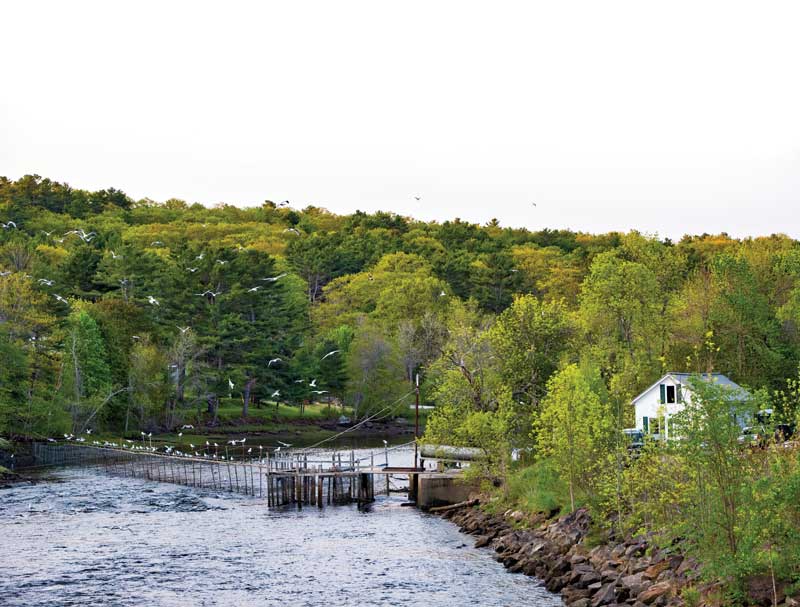 An alewife weir stretches across the Saint George River in Warren.
An alewife weir stretches across the Saint George River in Warren.
For most of the year, the downtown Warren village is as sleepy as they come. Running directly through town, the meandering Saint George River gives Warren the classic serenity found in much of rural Maine. However, every year for a few weeks after Mother’s Day, the quietude is disrupted by a fascinating natural event—the alewife run.
Millions of the unassuming little fish return from the Atlantic Ocean every May to race up Maine rivers to spawn. Alewives are a unique and tenacious fish. They are a diadromous species, meaning they can survive in both salt and freshwater conditions, just like salmon, shad, sturgeon, and American eels. The sudden spring bounty of small defenseless alewives is critical for Maine’s ecosystems because it makes an excellent meal for countless species of birds, mammals, and other fish. The fish are also an important natural resource for Mainers. Before the state was colonized by Europeans, alewives were harvested by tribes such as the Penobscot and Passamaquoddy for whom the fish was a staple. Today, alewives are important as traditional cuisine and as an asset for the state’s iconic lobster fishery.
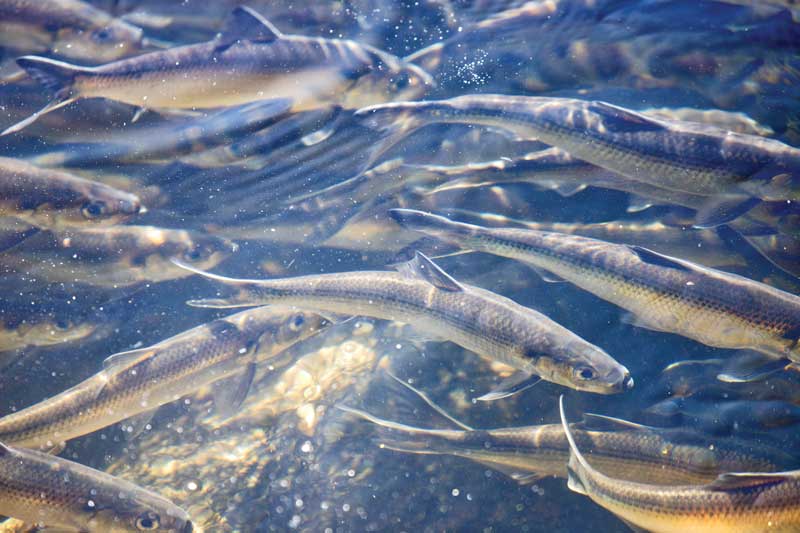 Alewives swim upstream during their annual spring migration.
Alewives swim upstream during their annual spring migration.
At the crack of dawn on a cool May morning, dozens of pickup trucks bring life to small-town Warren, all lining up to purchase crates of the coveted migratory fish. Alewives are diverted from their path upriver by a weir, a large fence-like enclosure that traps the fish at a dead end. They are then scooped out of the river with an over-sized net, loaded into the trucks, and driven back to the working waterfront to be used as bait in lobster traps. This local source of bait is affordable, environmentally sustainable, and effective. Anecdotally, traps baited with alewives yield a better catch of lobsters than those with other bait, making the fish a valuable commodity to fishermen.
If a lobsterman should find the line of trucks too long in Warren, they can try one of the other nearby alewife harvests. There are 21 harvest locations in Maine, the only state in the country with permitted sites. This may sound like a lot, but according to Jeffrey Pierce, president of Alewife Harvesters of Maine, we once boasted 4,000 harvest sites. This all changed in the 1990s. The alewife population experienced a precipitous drop, which was attributed to overharvesting and river blockages—primarily dams and culverts that impede fish migration. In recent years, however, this dramatic decrease in alewives provoked action by devoted Mainers, and each year, new river passages are restored for fish migration. Consequently, thanks to alewife activists, we are in the middle of a fishery renaissance.
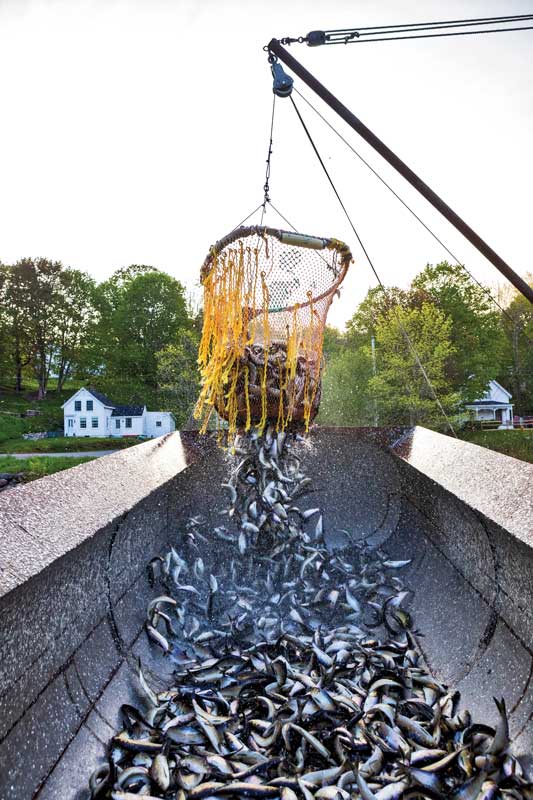 Alewives are hoisted out of the water with a net attached to a pulley system.The Nequasset Fish Ladder sits on the Sasanoa River in Woolwich, less than 45 minutes away from the Warren weir. This is where Steve Bodge runs his alewife harvest and smokehouse. Like many alewife harvests, you can find this one by following the signs on the side of the road that read “Smoked Alewives.”
Alewives are hoisted out of the water with a net attached to a pulley system.The Nequasset Fish Ladder sits on the Sasanoa River in Woolwich, less than 45 minutes away from the Warren weir. This is where Steve Bodge runs his alewife harvest and smokehouse. Like many alewife harvests, you can find this one by following the signs on the side of the road that read “Smoked Alewives.”
“Smokers go well with a six-pack of beer,” says Bodge “if you can get past picking them.”
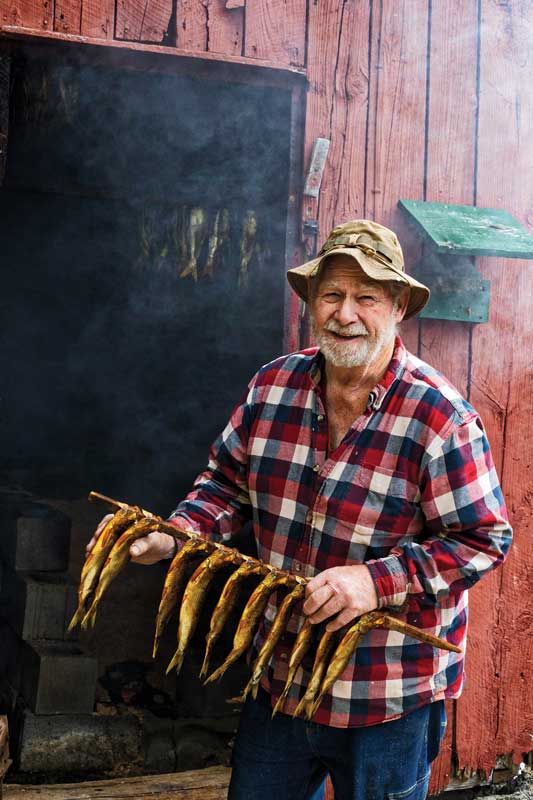 Steve Bodge stands outside of his smokehouse with a skewer full of smoked alewives, which he refers to as “smokers.”
Steve Bodge stands outside of his smokehouse with a skewer full of smoked alewives, which he refers to as “smokers.”
Bodge admits that smoked alewives may be salty and bony, but he still sells hundreds to loyal customers and to curious tourists alike. They are a tradition, although everyone has their own method for preparing smokers—baked, boiled, or microwaved—it’s all a matter of preference. One friend of Bodge’s comes down to the fish ladder each year, buys a handful of smoked alewives, cooks them, picks them, and blends them into a paté. The recipe has become a local delicacy.
Tradition is important to Bodge, as his family has been involved with the harvest for nearly a century.
“It gets in your blood after you’ve done it for so many years,” he reflects.
He remembers the early days, at 11 years old, when his stepfather would let him drive the truck home to Dresden after a day of scooping fish and shipping them out (this was before the days of heavy Wiscasset traffic on Route 1). The quantity and nature of the harvest was fundamentally different back then. In 2023, the harvest in Woolwich, which runs for about a month, yielded 1,400 bushels of alewives. By Bodge’s approximation, that’s almost a quarter of a million fish. In the 1970s, he remembers harvesting that many alewives in just a few days.
Bodge now keeps a watchful eye on the alewife population, ensuring enough fish make it upstream into Nequasset Lake, where they reproduce. This is how he knows he can count on a bigger return next year, but it is also required by law. If he wants to stay in operation, he must log each bushel he harvests and report it to the state. He is also required to take scale samples from the fish that are passing through. This helps researchers determine the age of the fish returning to the Nequasset Fish Ladder.
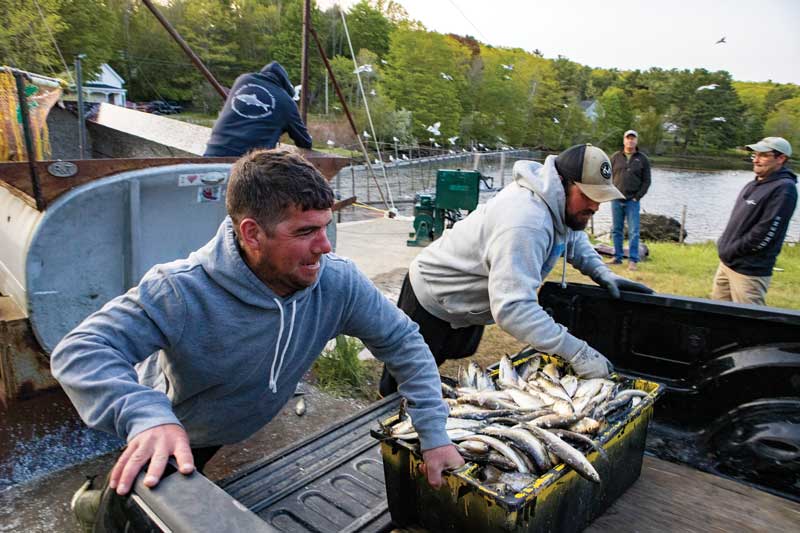 Lobstermen drive from several hours away to stock up on alewives.
Lobstermen drive from several hours away to stock up on alewives.
Bodge wants to keep the legacy of the alewife harvest alive, and expresses hope for the fishery’s future. He notes that the Nequasset Fish Ladder was replaced in 2015, and since then, he has seen an increase in the size of the fish run. Public knowledge around alewives continues to grow as well, and the fish is reasserting itself as a symbol of Maine heritage. And exposure to the next generation is fundamental to preserving any legacy, something Bodge understands well.
“I like to take my grandkids to the alewife run when I can,” he says, “You should see their eyes light up.”
✮
Jack Sullivan is a photographer and writer who grew up in southern Maine. He works for Island Institute as a multimedia storyteller and contributes to their publications. He lives in Waldoboro.






